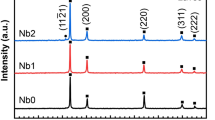Abstract
The electrochemical behavior and corrosion resistance of Ti–15Mo alloy to applications as biomaterials in solutions 0.15 mol L−1 Ringer, 0.15 mol L−1 Ringer plus 0.036 mol L−1 NaF and 0.036 mol L−1 NaF (containing 1,500 ppm of fluoride ions, F−) were investigated using open-circuit potential, cyclic voltammetry, and electrochemical impedance spectroscopy techniques, X-ray photoelectron spectroscopy and scanning electron microscope. Corrosion resistance and electrochemical stability of the Ti–15Mo alloy decreased in solutions containing F− ions. In all cases, there were formation and growth of TiO2 and MoO3 (a protector film), not being observed pitting corrosion, which might enable Ti–15Mo alloys to be used as biomedical implant, at least in the studied conditions, since the electrochemical stability and corrosion resistance of the passive films formed are necessary conditions for osseointegration.












Similar content being viewed by others
References
Kumar S, Narayanan TSNS, Kumar SS. Influence of fluoride ion on the electrochemical behaviour of β-Ti alloy for dental implant application. Corros Sci. 2010;52:1721–7.
Nakagawa M, Matsuya S, Udoh K. Corrosion behavior of pure titanium and titanium alloys in fluoride-containing solutions. Dent Mater J. 2001;20:305–14.
Kumar S, Narayanan TSNS. Corrosion behavior of Ti–15Mo alloy for dental implant applications. J Dent. 2008;36:500–7.
Oliveira NTC, Guastaldi AC. Electrochemical stability and corrosion resistance of Ti–Mo alloys for biomedical applications. Acta Biomater. 2009;5:399–405.
Stookey GK. Critical evaluation of the composition and use of topical fluorides. J Dent Res. 1990;69:805–12.
Huang HH. Effects of fluoride and albumin concentration on the corrosion behavior of Ti–6Al–4V alloy. Biomaterials. 2003;24:275–82.
Nakagawa M, Matono Y, Matsuya S, Udoh K, Ishikawa K. The effect of Pt and Pd alloying additions on the corrosion behavior of titanium in fluoride containing environments. Biomaterials. 2005;26:2239–46.
Al-Mayouf AM, Al-Swayih AA, Al-Mobarak NA, Al-Jabab AS. Corrosion behavior of a new titanium alloy for dental implant applications in fluoride media. Mater Chem Phys. 2004;86:320–9.
Tavares AMG, Fernandes BS, Souza SA, Batista WW, Cunha FGC, Landers R, Macedo MCSS. The addition of Si to the Ti–35Nb alloy and its effect on the corrosion resistance, when applied to biomedical materials. J Alloys Compd. 2014;591:91–9.
Martins DQ, Souza MEP, Souza SA, Andrade DC, Freire CMA, Caram R. Solute segregation and its influence on the microstructure and electrochemical behavior of Ti–Nb–Zr alloys. J Alloys Compd. 2009;478:111–6.
Afonso CRM, Aleixo GT, Ramirez AJ, Caram R. Influence of cooling rate on microstructure of Ti–Nb alloy for orthopedic implants. Mater Sci Eng C. 2007;27:908–13.
Eisenbarth E, Velten D, Müller M, Thull R, Breme J. Biocompatibility of β-stabilizing elements of titanium alloys. Biomaterials. 2004;25:5705–13.
Mareci D, Chelariu R, Gordin DM, Ungureanu G, Gloriant T. Comparative corrosion study of Ti–Ta alloys for dental applications. Acta Biomater. 2009;5:3625–39.
Gonzalez JEG, Mirza-Rosca JC. Study of the corrosion behavior of titanium and some of its alloys for biomedical and dental implant applications. J Electroanal Chem. 1999;471:109–15.
Robin A, Meirelis JP. Influence of fluoride concentration and pH on corrosion behavior of titanium in artificial saliva. J Appl Electrochem. 2007;37:511–7.
Oliveira NTC, Aleixo G, Caram R, Guastaldi AC. Development of Ti–Mo alloys for biomedical applications: microstructure and electrochemical characterization. Mater Sci Eng A. 2007;727:452–3.
Oliveira NTC, Guastaldi AC, Piazza S, Sunseri C. Photo-electrochemical investigation of anodic oxide films on cast Ti–Mo alloys. I. Anodic behaviour and effect of alloy composition. Electrochim Acta. 2009;54:1395–402.
Oliveira NTC, Guastaldi AC. Electrochemical behaviour of Ti–Mo alloys applied as biomaterial. Corros Sci. 2008;50:938–45.
Alves APR, Santana FA, Rosa LAA, Cursino AS, Codaro EN. Astudy on corrosion resistance of the Ti–10Mo experimental alloy after different processing methods. Mater Sci Eng C. 2004;24:693–6.
Al-Mayouf AM, Al-Swayih AA, Al-Mobarak NA, Al-Jabab AS. The effect of fluoride on the electrochemical behavior of Ti and some of its alloys for dental applications. Mater Corros-Werkstoffe Und Korros. 2004;55:524–30.
Niinomi M. Mechanical properties of biomedical titanium alloys. Mater Sci Eng A. 1998;243:231–6.
Leach JSL, Pearson BR. The conditions for incorporation of electrolyte ions into anodic oxides. Electrochim Acta. 1984;29:1271–82.
Oliveira NTC, Biaggio SR, Piazza S, Sunseri C, Di Quarto F. Photo-electrochemical and impedance investigation of passive layers grown anodically on titanium alloys. Electrochim Acta. 2004;49:4563–76.
Zhang X. The pitting behavior of Al-3103 implanted with molybdenum. Corros Sci. 2001;43:85–97.
Lavos-Valereto IC, Wolynec S, Ramires I, Guastaldi AC, Costa I. Electrochemical impedance spectroscopy characterization of passive film formed on implant Ti–6Al–7Nb alloy in Hank’s solution. J Mate Sci Mater Med. 2004;15:55–9.
Milosev I, Metikos-Hukovic M, Strehblow HH. Passive film on orthopaedic TiAlV alloy formed in physiological solution investigated by X-ray photoelectron spectroscopy. Biomaterials. 2000;21:2103–13.
Acknowledgments
The authors express their sincere acknowledgements to CNPQ for the scholarship and grant for making this work possible, and Isabela Mascia Silveira for the English revision of the manuscript.
Author information
Authors and Affiliations
Corresponding author
Rights and permissions
About this article
Cite this article
Rodrigues, A.V., Oliveira, N.T.C., dos Santos, M.L. et al. Electrochemical behavior and corrosion resistance of Ti–15Mo alloy in naturally-aerated solutions, containing chloride and fluoride ions. J Mater Sci: Mater Med 26, 1 (2015). https://doi.org/10.1007/s10856-014-5323-0
Received:
Accepted:
Published:
DOI: https://doi.org/10.1007/s10856-014-5323-0




